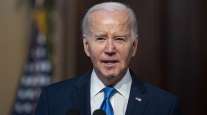Rule on Medical Examiners Issued
This story appears in the April 23 print edition of Transport Topics. Click here to subscribe today.
The Federal Motor Carrier Safety Administration released its long-anticipated national registry for certified medical examiners last week, requiring medical professionals who examine commercial drivers to receive training on driver health issues.
The final rule, released April 18, also requires the medical professionals to demonstrate proficiency on truck- and bus-driver issues by passing a test and then registering with a national database.
The requirements have a May 2014 deadline.The rule is intended to improve knowledge among those tasked with examining heavy- and medium-duty drivers to make sure they are healthy enough to engage in interstate commercial work. But critics said the rule might have the unintended consequence of driving some doctors, nurses, physician assistants and others out of the work, thereby raising the price of the required exams.
Congress ordered FMCSA to construct the rule in 2005 transportation legislation, and the Department of Transportation agency started work on the rule in December 2008.
“This new rule will ensure that health-care professionals conducting Department of Transportation medical exams fully understand all of the demands required to operate large trucks and passenger buses safely,” Transportation Secretary Ray LaHood said in a statement.
“Truck and bus drivers deserve highly trained medical examiners that think safety first,” FMCSA Administrator Anne Ferro said in the announcement. “By holding medical examiners accountable to high standards of practice, we raise the bar for safety and save lives through increased commercial driver and vehicle safety.”
The Owner-Operator Independent Drivers Association expressed skepticism.
“Ultimately, the rule means fewer options for drivers, which will translate into higher costs and have other unintended consequences. If a family physician who normally was used for DOT physicals stops providing that service because of the new rule, a driver has to find a new one who will know nothing about his or her history. That might mean additional tests and added costs, plus losing the value of a provider that knew your history,” said Todd Spencer, OOIDA’s executive vice president.
FMCSA said in the rule — which is available online via the Federal Register — that 40,000 examiners are expected to take training and get posted in the registry when it becomes mandatory in May 2014. Drivers and motor carriers will have to use a certified examiner from the registry, and examiners cannot get on the registry unless they have received training and have passed FMCSA’s test.
FMCSA anticipates that about 3 million drivers a year will be tested, as drivers usually must get a certificate every other year — but sometimes more often.
“A new medical specialty has been created. Some examiners will specialize in doing just this, and they’ll do a lot of it,” said Michael Megehee, a Pendleton, Ore., chiropractor and president of TeamCME, a national network of certified medical examiners for transportation workers.
Megehee said his group is already developing plans to train medical examiners for taking the certification test. His own plan is to offer one- and two-day courses for examiners seeking training.
“Some doctors don’t like this rule because of the training requirement. Personally, I don’t mind taking the training and the testing, and I think I’ll be a better doctor because of it,” said Megehee, who said he has been doing 700 to 1,000 driver examinations a year.
The driver exams cover many operators of Classes 3-6 vehicles and almost all operators of Classes 7 and 8 vehicles. Examiners can be medical doctors, chiropractors, osteopaths, physician assistants or advanced-practice nurses licensed by a state. While the examiners are expected to know about driver health issues, until now there have been no standards to back up those expectations.
Truckload carrier Schneider National has found a wide array of variety in examiners, said Thomas DiSalvi, Schneider’s director of safety and loss prevention.
“There are a lot of examiners out there, and we’ve experienced both. Some have a very clear understanding of what’s going on, while others don’t know about the very physical demands on drivers,” DiSalvi said.
Schneider, based in Green Bay, Wis., was frequently mentioned in the FMCSA rule and commented heavily during the proceedings. DiSalvi said that for Schneider, almost 50% of the exams are performed by nurses and about 30% by physician assistants.
The rule states that driver health plays a critical role in highway safety.
The agency itself said there are about 440,000 commercial vehicle crashes each year and that commercial driver physical impairments play a role in about 9,690 of those accidents.
FMCSA said the new process should eliminate 1,220 of those crashes a year, and if it does, it will save the nation almost $190 million a year — or $155,000 a crash.
“It’s a rule we welcome, and I think it can only help,” said Boyd Stephenson, manager of safety and security operations for American Trucking Associations.
Stephenson said fleet managers should note that, as of the 2014 effective date, carriers must make sure the medical professionals examining their drivers are listed on the FMCSA registry.
He also said FMCSA is expected to come forth with a related rule that would allow for online entry of medical reports directly into a national data base. Stephenson said that would greatly reduce the possibility of fraud related to medical certificates.



